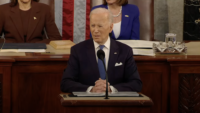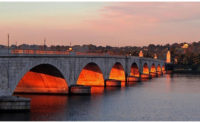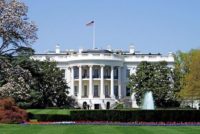Demolition work continues at the site of the fallen Francis Scott Key Bridge, as President Joe Biden reiterated his vow to "move heaven and earth to rebuild this bridge as rapidly as humanly possible."
Speaking on April 5 with the Patapsco River and the steel skeleton of the collapsed Francis Scott Key Bridge in the background, Biden added that the new bridge would be built "with union labor and American steel.”
Biden described the scene in stark terms, saying, “The damage is devastating” and that the bridge “has been ripped apart” and that he saw thousands of tons of mangled steel” that the team would try to remove “as quickly and safely as possible.”
The Unified Command overseeing recovery and demolition operations at the bridge site announced April 5 that crews had recovered remains of one construction worker lost in the collapse. Identified as 38-year-old Maynor Yasir Suazo-Sandoval, he was one of eight workers on the bridge at the time of the collapse. They were repairing potholes in the concrete deck for contractor Brawner Builders Inc., Hunt Valley, Md. Two survived and three bodies had been recovered previously. Three other workers still are missing, as dangerous conditions continue to hamper the search.
Biden said that his administration is “absolutely committed to ensure that the parties responsible for this tragedy would repair the damage and be held accountable to the fullest extent the law will allow.”
But Biden also said, “I fully intend … to have the federal government cover the costs of rebuilding this entire bridge—all of it.”
He also said the administration would “support Maryland and Baltimore every step of the way to help you rebuild.”
Biden announced that the federal government would provide $8 million to make infrastructure improvements at nearby Sparrows Point, which is situated outside the restricted zone, to enable that areas to receive more ships.
One of the massive cranes removing the wreckage of the Francis Scott Key Bridge has a long and colorful history starting with a Cold War nuclear sub recovery. In 2017, ENR’s Nadine Post penned a detailed article on the Chesapeake 1000 crane.
Read the article
On April 4, the U.S. Army Corps of Engineers in a press release said it expects to open a limited access channel 280 ft wide x 35 ft deep, to the Port of Baltimore by the end of April. This channel would allow for barge container service and some roll on/roll off vessels that move automobiles as well as construction and farm equipment to and from the port.
The release said that Corps engineers are aiming to reopen the permanent, 700-ft-wide x 50-ft-deep federal navigation channel by the end of May, restoring port access to normal capacity.
According to a US. Coast Guard release, two temporary channels are now open. Sollers Point Temporary Channel has a controlling depth of 11 ft, a 264-ft horizontal clearance, and vertical clearance of 95 ft. The Hawkins Point Temporary Channel has a controlling depth of 14 ft, a 280-ft horizontal clearance, and vertical clearance of 124 ft. U.S. Coast Guard Rear Admiral Shannon Gilreath expressed hope that a third channel with a potential controlled depth of up to 25 ft could also open that “should allow us to move almost all of our tug and barge traffic in and out of the Port of Baltimore.”






Post a comment to this article
Report Abusive Comment